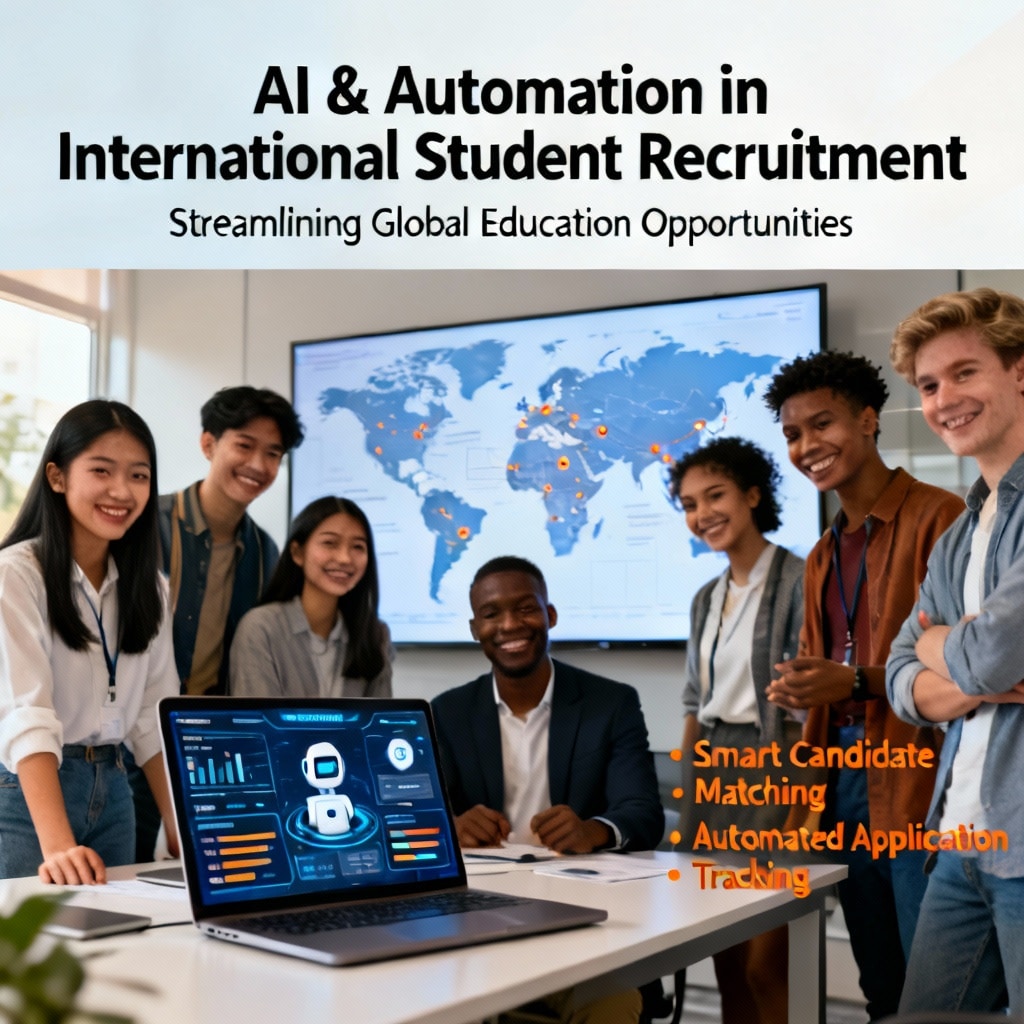AI and Automation in International Student Recruitment
- AI and Automation in International Student Recruitment
- Why this matters now
- Key benefits for recruiters and admissions teams
- High-impact use cases and how to implement them
- Roadmap to implement AI and automation
- Common pitfalls and how to avoid them
- Conclusion
- Take the Next Step with Study in Turkiye
AI and Automation in International Student Recruitment
AI and Automation in International Student Recruitment are transforming how universities, agents, and recruitment teams source, assess and enroll international students. For HR, marketing, and admissions professionals, the opportunity is clear: automate routine tasks, personalize outreach at scale, and make data-driven decisions that improve conversion rates and student experience.
Turkiye’s higher education landscape — with 208 universities and more than 45,000 programs — is uniquely positioned to benefit from this shift. Turkish institutions already implement the Bologna Process and ECTS, offer wide language options and modern campus life, and attract diverse international cohorts. Integrating AI-enabled recruitment tools accelerates growth while preserving the human touch that international students value.
Why this matters now
- Rapid growth in international applications demands scalable solutions. Many admissions teams still rely on manual processes that slow response times and reduce conversion.
- Students expect instant, personalized communication across channels (chat, email, social).
- Compliance, document verification and visa processing require accurate, auditable workflows that automation can deliver.
- Turkiye’s competitive position (affordable tuition, English programs, cultural diversity) means institutions can convert demand into enrollment if their recruitment operations are modernized.
Key benefits for recruiters and admissions teams
- Faster response times and higher engagement via AI chatbots and automated email flows.
- Higher-quality lead qualification through predictive scoring and intent analysis.
- Reduced operational cost and increased throughput by automating repetitive tasks (document checks, eligibility screening).
- Better student experience with personalized program recommendations and clear guidance on admissions and visa steps.
High-impact use cases and how to implement them
1. Lead capture and qualification
What to automate: web forms, CRM ingestion, automated lead scoring based on program fit, language, budget, and intent.
Action steps:
- Integrate website forms with your CRM and marketing automation.
- Use predictive models to rank leads and route high-priority prospects to counsellors.
- Monitor conversion metrics (lead-to-application, lead-to-enrolment).
KPI: increase in qualified leads, reduced time-to-contact.
2. Conversational AI for 24/7 engagement
What to automate: FAQ handling, pre-screening questions, scheduling interviews, campus tour bookings.
Action steps:
- Deploy a multilingual chatbot on landing pages and social channels.
- Train bot flows for program-specific queries (e.g., medicine programs at Istinye University or Istanbul Medipol University).
- Escalate complex queries to human agents with conversation context.
KPI: decreased first response time, improved engagement rate.
3. Automated document processing and verification
What to automate: transcript recognition, credential validation, ID/passport checks.
Action steps:
- Implement OCR and document-classification pipelines.
- Create a standardized checklist per program (e.g., additional requirements for health or medicine faculties).
- Build an exceptions queue for manual review.
KPI: faster document clearance, fewer missing-doc delays.
4. Personalized outreach and application nurturing
What to automate: segmented email and SMS sequences, content personalization, program recommendations.
Action steps:
- Map student journeys (prospect → applicant → enrollee).
- Use dynamic content to adapt messaging by region, program and stage.
- A/B test subject lines and call-to-action messaging.
KPI: higher email open/click rates and application completion.
5. Predictive analytics and yield optimization
What to automate: propensity models to predict enrolment likelihood, optimal scholarship allocation.
Action steps:
- Build models using historical application and enrolment data.
- Allocate counseling resources and scholarship offers based on predicted yield lift.
KPI: improved yield rate, optimized scholarship ROI.
Roadmap to implement AI and automation (practical, staged approach)
Stage 1 — Audit and prioritize
- Map your current recruitment funnel, identify bottlenecks and manual-intensive tasks.
- Prioritize use cases by expected impact and implementation complexity (start with chatbots and email automation).
Stage 2 — Technology and integration
- Select a recruitment CRM and marketing automation platform that supports APIs and multilingual content.
- Ensure easy integration with SIS, scholarship systems and document management.
- Example: integrate chatbots on university program pages (for example, program pages at Istinye University and Medipol University) to capture program-specific queries.
Stage 3 — Data governance and privacy
- Establish data protection policies and consent workflows, aligned with local regulations.
- Maintain auditable logs for visa-related documents and decisions.
Stage 4 — Pilot and refine
- Run small pilots with defined success metrics (engagement, qualified lead rate, reduction in manual hours).
- Iterate bot dialogues and scoring models using real user interactions.
Stage 5 — Scale and optimize
- Roll out successful pilots across programs and campuses.
- Continuously monitor model drift and user feedback.
Common pitfalls and how to avoid them
- Over-automation: Preserve human touch for high-value interactions like scholarship decisions and final counseling.
- Poor integration: Avoid isolated tools; ensure systems talk to each other (CRM ↔ SIS ↔ document stores).
- Ignoring language: Deploy multilingual models—Turkiye attracts students who prefer English, Turkish or other languages.
- No feedback loop: Continuously retrain models and improve bot scripts with real conversation data.
Conclusion
AI and automation in international student recruitment are not a one-size-fits-all solution, but when implemented thoughtfully they can dramatically increase efficiency, improve yield and elevate student experience. For institutions and agencies working with Turkiye’s universities, the combination of modern technology and Study in Turkiye’s platform and services creates a scalable, student-centered recruitment model.
Take the Next Step with Study in Turkiye
Ready to modernize your international recruitment operations? Partner with Study in Turkiye to pilot AI-driven admissions workflows, integrate with our SIT Search and admission support, and access our network of leading universities.

